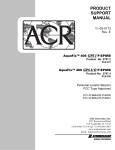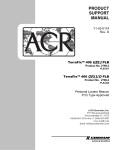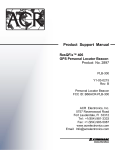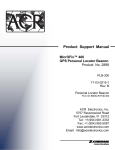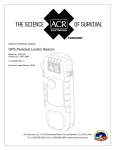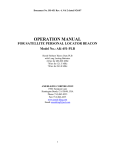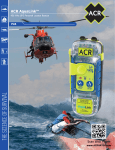Download ACR Electronics AEROFIX 406 GPSIOP-ELT Technical data
Transcript
PRODUCT SUPPORT MANUAL Y1-03-0175 Rev. E AeroFix™ 406 GPS I P-ELT Product No. 2799.2 PLB-201 AeroFix™ 406 GPS I/O P-ELT Product No. 2799.4 PLB-200 Personal Locator Beacon FCC Type Approved FCC ID:B66ACR-PLB200 FCC ID:B66ACR-PLB201 ACR Electronics, Inc. 5757 Ravenswood Road Fort Lauderdale, Fl 33312 +1(954) 981-3333 • Fax +1 (954) 983-5087 www.acrelectronics.com Email: [email protected] * * * WARNING * * * THIS TRANSMITTER IS AUTHORIZED FOR USE ONLY DURING SITUATIONS OF GRAVE AND IMMINENT DANGER * * * DELIBERATE MISUSE MAY INCUR A SEVERE PENALTY * * * For proper use refer to section 2 – Responsible Use PLEASE READ ALL INSTRUCTIONS BEFORE PERFORMING ANY OF THE TESTS. Forward Congratulations and thank you for purchasing the ACR AeroFix™ 406 GPS Personal Emergency Location Transmitter. The combination of superior design, high quality raw materials and quality controlled manufacturing produce a product that will perform for years to come. The Test Facility at ACR can reproduce some of the harshest environmental conditions known to man. This assures that the life saving devices can stand up to the rigors found in any environment on earth. With proper care and maintenance, your P-ELT will be in service for years to come. ACR is proud to be certified to the ISO 9001:2000, the International Standard for Quality. This manual provides operation and maintenance instructions for the AeroFix™ 406 GPS P-ELT, hereinafter referred to as the P-ELT. This manual also describes the characteristics and details of the P-ELT System. Table of Contents 1.0 Registration.................................................................................................................................. 2 2.0 Responsible Use .......................................................................................................................... 4 3.0 False Alarms................................................................................................................................ 4 4.0 Operation ..................................................................................................................................... 5 5.0 P-ELT Holster.......... ................................................................................................................... 9 6.0 Care and Maintenance ................................................................................................................. 10 7.0 The Search and Rescue System................................................................................................... 11 8.0 Authorizations ............................................................................................................................. 13 9.0 Technical Data............................................................................................................................. 14 10.0 GPS FAQ..................................................................................................................................... 15 11.0 Warranty ...................................................................................................................................... 16 Figure 1 Key Pad functions.................................................................................................................. 5 Figure 2 Antenna Position ................................................................................................................... 6 Figure 3 Keypad Cover........................................................................................................................ 6 Figure 4 Activation .............................................................................................................................. 6 Figure 5 Deactivation........................................................................................................................... 6 Figure 6 GPS Interface with holster..................................................................................................... 9 Figure 7 GPS Interface without holster ............................................................................................... 9 Figure 8 Removable holster ................................................................................................................. 10 Figure 8 Bulk Head Mount .................................................................................................................. 10 Figure 10 GEOSAR Satellite Coverage................................................................................................. 13 Figure 11 Satellite Orbit......................................................................................................................... 13 1 Y1-03-0175 Rev. E SECTION 1 - REGISTRATION OF 406 MHz P-ELTS 1.1 Registration Importance It is mandatory that the owner of this 406 MHz P-ELT registers it with the National Authorities*. All 406 MHz P-ELTs transmit a Unique Identifier Number (UIN) when activated. This UIN is programmed in the P-ELT based on the country in which the P-ELT was purchased. Registration provides the Search and Rescue (SAR) forces with emergency contact information, and will speed the launch of a rescue operation. The National Authorities use the information to verify if an actual emergency exists. Valuable Search and Rescue resources are wasted every year responding to false alarms. For P-ELTs that are not registered, SAR authorities will not know who you are, or who to contact regarding additional information of your current situation. This could delay the launch of a rescue operation. *A National Authority is the governmental body that is responsible for P-ELT Registration Database administration for the country for which the P-ELT is programmed. 1.2 Where to register The owner of a 406 MHz P-ELT should register it with the National Authority of which the P-ELT was programmed, (typically the country where purchased), regardless of where you use your P-ELT. Each P-ELT is programmed with a UIN for the country where the unit is shipped, and will only be accepted for registration in that country. To verify the country, for which a P-ELT is programmed, see the label with the UIN on the back of the unit. Units that do not have a country specified on the UIN label are programmed for the United States. For a list of the national authorities in your area, please view them at http://www.cospas-sarsat.com/Management/listOfParticipants.htm 1.3 Registration in the United States It is the Owner’s responsibility and required by law to Register 406 MHz P-ELTs that are programmed for and purchased in the United States. The National Authority that accepts registrations in the United States is the National Oceanic and Atmospheric Administration (NOAA). The owner should complete the enclosed registration form (Do not confuse this with the ACR Electronics Warranty Card) and mail it with the pre-addressed; postage paid envelope to: SARSAT Beacon Registration, E/SP3, RM 3320, FB-4 NOAA/NESDIS 5200 Auth Rd. Suitland, MD 20746-4304 P-ELT registration is also available online at: www.beaconregistration.noaa.gov The information provided on the Registration Form is used only for rescue purposes. The Registration Form should be filled out and mailed immediately. Registration can be expedited by faxing the registration form or by completing the form online in the event the P-ELT is to be placed in immediate use. Typically, registration forms will be entered in the 406 MHz P-ELT Registration Database within 48 hours of receipt. A confirmation letter, a copy of the actual registration and a proof-of-registration decal will be mailed to you within two weeks. When you receive these documents, please check the information carefully and affix the decal to your P-ELT in the area marked “Beacon Decal here”. If you do not receive confirmation, contact NOAA for additional information at: +1-888-212-7283. 2 Y1-03-0175 Rev. E 1.3.1 Registration in Canada The National Authority in Canada is the NSS (National Search & Rescue Secretariat). Canadian residents can register online at http:beacons.nss.gc.ca. For more information please contact the NSS at (613) 966-1504 or (800) 727-9414. National Search and Rescue Secretariat 400-275 Slater Street Ottawa, Ontario K1A 0K2 1.4 Registration Outside of the United States In countries other than the United States, 406 MHz P-ELTs are registered with that country’s National Authority at the time of Purchase. The Sales agent should assist in filling out the forms and sending to that country’s National Authority. To verify that the unit is properly programmed for that country, view the UIN label on the side of the unit. In the event that the P-ELT is not programmed for the country in which it has been purchased, the sales agent, (if properly equipped) can reprogram the unit for that country. 1.5 Change of ownership or contact information It is the owner’s responsibility to advise the National Authority of any change in the information on the registration form. If the current owner of the P-ELT is transferring the P-ELT to a new owner, the current owner is required to inform the National Authority by Letter, Fax or telephone, of the name and address of the new owner. The new owner of the P-ELT is required to provide the National Authority with all of the information requested on the Registration form. This obligation transfers to all subsequent owners. Registration forms are available from NOAA, call +1(888) 212-7283 or visit our website at www.acrelectronics.com. 1.6 Lost P-ELT’s Inform NOAA immediately at 1-888-212-SAVE (7283), or your national authority, that your P-ELT has been lost. They will update your P-ELT registration information with the appropriate information. 1.7 Stolen P-ELT’s Things That You Need To Do: • Report to your local police department that the P-ELT has been stolen. • Contact NOAA at 1-888-212-SAVE (7283), or your national authority, with the following information so your P-ELT registration information can be updated with the appropriate remarks: - Police Department Name - Police Phone Number - Police Case Number If your P-ELT were to activate, the information you provide will be forwarded to the appropriate Search and Rescue Authorities who will ensure that your P-ELT gets back to you. And, if someone attempts to register a P-ELT reported as stolen, NOAA or your national authority will notify the appropriate Police Department. Visit the COSPAS-SARSAT website for more detailed information: www.cospas-sarsat.org/ 3 Y1-03-0175 Rev. E SECTION 2 – RESPONSIBLE USE 2.1 The AeroFix™ 406 GPS P-ELT should only be used in situations of grave and imminent danger! What exactly does this mean? Technically speaking you should only activate your P-ELT when all other means of self rescue have been exhausted. This means you have tried to use your cellular/satellite phone, signaling mirrors, strobe lights, or any other safety device you may have. When all else fails and you feel your situation has truly become extreme, ask yourself the following questions: Am I in danger of losing life, limb, eye sight, or valuable property if I am not rescued soon? Am I in danger of not surviving the night or upcoming hours if not rescued soon? If you answer yes with confidence to these questions, it is time to activate your P-ELT. SECTION 3 - FALSE ALARMS 3.1 Preventing False Alarms • Ensure that your P-ELT is registered with NOAA or your national authority. This does nothing to reduce false alarm rates, but does have a dramatic effect on the impact of a false alarm. If the P-ELT is properly registered, the situation will be resolved with a phone call most of the time. It will also help speed rescue in an actual distress. • Test your P-ELT in accordance with the recommendations enclosed in this manual. • Use care when leaving your P-ELT and with whom you leave it with. Ensure that they are aware of the device and know the ramifications of causing a false alarm. A lot of false alarms are generated by curious individuals. • Maintain your P-ELT. Ensure that the batteries are within their expiration date and that all manufacturer recommendations are followed. • Finally, realize that the COSPAS-SARSAT satellites are very good at what they do, detecting emergency P-ELTs. An activation of a 406 MHz P-ELT for just a few seconds will usually be detected. After a few minutes, it will usually be detected and located. This is good if you're in distress, but if you're not, you just generated a false alarm. 3.2 Should there be an inadvertent activation or false alarm, it must be reported to the nearest search and rescue authorities. The information that should be reported includes the P-ELT Unique Identifier Number (UIN), Date, Time, duration and cause of activation, as well as location of P-ELT at the time of activation. Outside the United States contact your National Authority. 3.3 To report false alarms in the United States contact any of the following: AFRCC-United States Air Force Rescue Coordination Center 4 Tel: (800) 851-3051 Y1-03-0175 Rev. E SECTION 4 - OPERATION 4.1 General The AeroFix™ 406 GPS P-ELT models are designed to be manually deployed and activated. It is only to be activated when all other means of self-rescue have been exhausted. Activation of the P-ELT tells Search and Rescue who you are, where you are, and that you are facing a life threatening situation. GPS Test Button - GPS I (P/N 2799.2) - GPS I/O (P/N 2799.4) Self Test Button Green & Red LED Off Button GPS Interface ON Press both test and GPS buttons together for 1 second to activate the beacon in an emergency Figure 1. Key Pad Functions (P/N 2799.4 shown) 4.2 AeroFix™ 406 GPS P-ELT Emergency Activation 4.2.1 Activation To activate your P-ELT in an emergency situation, unfasten the antenna from the case or holster and move it into the upright position (See figure 2). Lift the holster cover revealing the P-ELT keypad (see figure 3). Depress the “self-test” and “GPS I” or “GPS I/O” buttons simultaneously for at least 1/2 second and less than 5 seconds (see figure 4). Your P-ELT is now activated. While transmitting your emergency signal, the red LED will flash once every 2 seconds alerting you that your P-ELT is activated. If GPS data is present in the P-ELT via the GPS I or GPS O the red LED will turn off and the green LED will take over flashing once every 2 seconds. 4.2.2 Activation with GPS I (P/N 2799.2 and P/N 2799.4) The AeroFix™ 406 GPS I and GPS I/O are equipped with a GPS Interface. Prior to activating your P-ELT you can download your GPS LAT/LON into the P-ELT using an external GPS receiver and the GPS Interface cable provided with the P-ELT. Once your external GPS has acquired good global positioning data, press the GPS test button for at least ½ second and no longer than 5 seconds and your GPS data will download into the P-ELT (for full instructions see Section 4.7.2). Once you activate your P-ELT, your GPS coordinates are included in the distress signal. The green LED will immediately start flashing every 2 seconds to alert you that your P-ELT is activated and transmitting your GPS coordinates with the 406 MHz signal. 5 Y1-03-0175 Rev. E 4.2.3 Activation with GPS I/O (P/N 2799.4 Only) The AeroFix™ 406 GPS I/O is also equipped with an Onboard GPS receiver. Once activated the AeroFix™ 406 GPS Onboard GPS engine will start up and search to find your LAT/LON and incorporate it into your 406 MHz signal. In the case when external and internal GPS are present, the internal GPS data will have priority at activation. When the AeroFix™ 406 GPS I/O is turned ON, the GPS Onboard receiver is also immediately turned ON and will immediately begin acquiring data. As soon as the GPS receiver acquires good positioning data the red LED will stop blinking and the green LED will begin flashing once every 2 seconds. Once good global positioning data has been obtained, the GPS receiver waits for 20 minutes before looking for new positioning data again. If for any reason a time period of 4 hours passes without the GPS receiver being able to update the last good set of GPS coordinates, the message transmitted by the AeroFix™ 406 GPS I/O will revert to default data. At this point the green LED will stop blinking and the red LED will flash once every 2 seconds. If at any time after this, good GPS data is obtained, this data will be transmitted, the red LED will stop blinking and the green LED will begin flashing again. Unlock and position Upright Z X Figure 3 Key pad cover Open the key pad cover for access to Test or activate the beacon Y Figure 2 Antenna Position Figure 4 Activation Press both test buttons simultaneously for more than ½ second and no longer than 5 seconds Figure 5 Deactivation Press red OFF button for more than ½ second 6 Y1-03-0175 Rev. E 4.2.4 4.3 GPS Antenna Orientation (2799.4 ONLY) When activated it is critical that you do not cover the front bottom portion of the P-ELT with any body part, water, clothing, etc. The GPS Antenna is located under the front bottom portion of the case behind the embossed ACR logo. To ensure proper operation it needs to be unobstructed with a clear view to the sky. Avoid submerging this portion of the P-ELT in water if possible, as water will shield and inhibit the GPS receiver and may cause difficulties obtaining LAT/LON coordinates. 406/121.5 Antenna Position For maximum performance you must deploy the P-ELT antenna into the proper position (see figure 2). The antenna will snap into place and be slightly slanted to the side. Be sure the antenna is positioned facing the sky and avoid submerging in water. If afloat employ all means to keep the P-ELT out of the water and the antenna dry. For best results it is important to keep the antenna dry and away from the water. Water acts as a detractor from the performance and reduces the P-ELT’s effectiveness. 4.4 Deactivation To deactivate your P-ELT, depress the “OFF” button for 1 second (see figure 5). Once off, all blinking LED’s will stop signifying that the P-ELT is no longer sending your rescue message. 4.5 Self Test PLEASE READ ALL INSTRUCTIONS BEFORE PERFORMING ANY OF THE TESTS. BE PREPARED TO RECORD DATA FROM THE TEST Self test is initiated by holding the self test button (see figure 1) for at least ½ second and less than five seconds. Your P-ELT will sound an initial beep and green LED (Light Emitting Diode) flash to signify the test has begun. The green LED will flash a second time to indicate that the self test was successful. AeroFix™ 406 GPS I (P/N 2799.2) self tested components: Data Integrity and Memory; 406 MHz Synthesizer; RF Power/Battery AeroFix™ 406 GPS I/O (P/N 2799.4) self tested components: Data Integrity and Memory; 406 MHz Synthesizer; RF Power/Battery; GPS header If your P-ELT flashes two green LED’s, the test has been successfully completed. If you encounter only the initial green LED flash alone, your P-ELT has failed the self test, please contact ACR Electronics or an authorized Battery Replacement Center for servicing of your P-ELT. NOTE: During a self test your P-ELT will send a 406 MHz signal coded as self-test to the satellite system. The homing signal at 121.5 MHz is inhibited during self test; this allows you to test your P-ELT any time during the day without causing any false alarms. 4.6 Battery Witness Seal Life ACR strongly recommends performing the self test on the AeroFix™ 406 GPS on a monthly basis. If your P-ELT flashes an initial Red LED at the beginning of the Self Test, this indicates that your electronic witness has been broken and you have used more than 1 hour of battery life. While the P-ELT will still operate normally in an emergency, ACR strongly recommends you have your battery replaced and the electronic witness reset to ensure that you will have 24 hours of battery power should you ever need to activate your unit in an emergency 7 Y1-03-0175 Rev. E 4.7 GPS Testing 4.7.1 GPS O (Onboard) Test (P/N 2799.4 only) This test is NOT necessary as 100% of all Onboard GPS receivers that leave ACR have been tested to ensure they perform perfectly. However, if you would like to ensure your Onboard GPS is working properly, please follow these instructions very closely. Warning: To conserve battery power the following test should not be performed more than once during the five-year life of the battery pack! Note: The GPS Antenna is located under the bottom front portion of the case behind the embossed ACR logo. It is imperative that this location not be obstructed during self test or activation to ensure that the GPS antenna is acquiring your latitude and longitude position. This test must be performed outside with a clear view of the sky. The AeroFix™ 406 GPS P-ELT is fitted with an internal Global Positioning System (GPS) receiver that will determine the latitude and longitude of its position. To test the internal GPS you must be outdoors and have a clear view of the sky. The P-ELT must remain under observation in order to witness the results of the test. In order to best view the results, avoid bright sunlight and noisy locations. Depress and hold the GPS I/O button until one Red LED flash, beep and one Green LED flash, beep are observed. (about 5 seconds apart) Then release the GPS I/O button. The live test of the internal GPS has begun. The GPS will remain ON until LAT/LON position coordinates have been obtained or until 10 minutes has elapsed. If valid navigation data has been obtained, the GPS will be turned OFF and the green LED will light for at least 3 seconds. This LAT/LON data is not saved for use when the P-ELT is turned ON. The green LED is proof that the GPS is functioning properly and that the P-ELT is in a location or environment where it can receive the necessary signals from satellites. If the GPS does not acquire good navigation data, the GPS will turn OFF after 10 minutes and there will be no successful green LED indication. This test should not be performed more than once during the five-year life of the battery pack to prevent excessive battery drain. 4.7.2 Preload external GPS I (Interface) The AeroFix™ 406 GPS P-ELT (P/N 2799.2 and 2799.4) can interface with a handheld GPS receiver to provide your LAT/LON to SAR forces and narrow your search area to 110 yards (100 meters). The P-ELT can accept NMEA 0183 version 1.5 and above GPS Data (format GPGGA sentence) through its infra-red interface. The P-ELT can be forced to update its GPS data by pressing the GPS I or GPS I/O button for at least 1/2 second and not longer than 5 seconds only when the beacon is off. The AeroFix P-ELT will hold the last GPS coordinates in memory for 4 hours before returning to the default. Upon activation, your GPS data will be transmitted to the GEOSAR satellite on the very first burst. AeroFix 406 P-ELT will interface with most GPS receivers, if you are not sure if your receiver is NMEA 0183 compliant please check the interface settings listed in your GPS manual. Maximum 500 preloads during the life of the battery. To optimize your GPS Interface feature be sure that your portable GPS receiver is equipped with the following: NMEA 0183 Version 1.5 or higher GPGGA sentence is enabled 8 Y1-03-0175 Rev. E Figure 6. GPS Interface with holster 4.7.3 Figure 7. GPS Interface without holster GPS I (Interface) connection The AeroFix™ 406 GPS P-ELT (P/N 2799.2 and 2799.4) comes standard with an Optical GPS data interface with LED (Hard wire connection to you onboard GPS NEMA 0183 output). Connect the serial port adapter to your external GPS connection data cable. Connect data plus and minus leads to your NEMA 0183 output wire (consult onboard GPS manual for proper wiring instructions). The ONLY reliable way to hook up your aviation electronics is to solder the leads together, cover the solder connection and exposed wire with liquid electrician’s tape, and then slips a section of heat shrink over the outside and seals it in place. If the holster is on the P-ELT, align the two tabs on the bottom of the interface with the holes in on the holster directly above the interface port (see figure 6). Push down and turn to secure the interface cable to the holster. If the holster in not on the P-EPIRB simply hold the interface head on top of the interface port with your finger (see figure 7). SECTION 5 – P-ELT Holster and Bulk Head Mount 5.1 The AeroFix™ comes standard with a protective holster that will help protect your P-ELT from damage. To install the holster, deploy the antenna and slide antenna through the open hole located on the left side of the holster. Slide the holster to the base of the P-ELT so that the open antenna hole is flush with the side of the P-ELT. Close the back of the holster around the back of the P-ELT and clip into the front of the holster. Once secured, wrap the antenna around the base of the holster and clip into antenna slot on the top right side of the holster (See figure 8). Note: Use extreme caution; do not apply the holster over the antenna. In an emergency it is critical that you deploy the antenna. If the holster is covering the antenna you will not be able to deploy properly. 5.2 The AeroFix™ holster has been designed to accommodate your extreme adventures. You can secure your P-ELT directly to backpack webbing straps or belts to ensure the P-ELT is close at hand. Ensure the P-ELT is secured firmly and is protected before heading out to avoid damage or loss. ACR recommends that you secure your P-ELT someplace that is easily accessible in case of an emergency for rapid activation. 9 Y1-03-0175 Rev. E Note: Use care when attaching items to your P-ELT. Clipping attachments, carabineers, rope, webbing, etc. will all add weigh and can affect the buoyancy of the P-ELT. Your P-ELT may not float if items have been attached to it. Figure 8. Removable Holster To secure antenna when the holster is on your AeroFix™, be sure to deploy antenna prior to placing the holster onto the unit. Slide the antenna through the holster to secure it to the beacon. The holster will clip together at the bottom of holster. Rotate antenna into down position in order to wrap it around the holster to lock it in place. Make sure the antenna runs between the two guides on the bottom of the holster. This will prevent the antenna from slipping out of position. Finally lock the antenna into place by engaging the tab located on the antenna into the slot provided on the top right corner of the holster. Slide it in to lock in place. To Open the Holster, squeeze inward on the two tabs located on the bottom clip and pull up on the top of the holster. Rotate antenna up, and slide the holster off around the antenna. 5.3 The AeroFix™ also comes with a bulk head mounting clip that allows you to easily mount your PELT to your console or bulk head. Simply bolt the mounting clip to your desired location and slide the P-ELT onto the clip ensuring that the bottom back of the holster slides over the clip to secure it in place (See figure 9). Connect GPS Interface Cable to the bulk head mount when P-ELT is not attached. Figure 9. Bulk Head Mount Holster opening for the bulk head mount. 10 Y1-03-0175 Rev. E SECTION 6 - CARE AND MAINTENANCE 6.1 Carefully inspect the P-ELT case and gasket for any visible cracks. Cracks may admit moisture, which could cause a malfunction. In the event of any cracking or structural damage, the P-ELT should be immediately sent to ACR for evaluation and repairs, (1-800-432-0227). 6.2 Do Not clean your P-ELT with household cleaners and hydrocarbon materials such as gasoline, benzene, bleach, sanitizers, soaps, etc., simply wipe your P-ELT down with a damp cloth until clean. 6.3 Battery Replacement Power is provided by self contained long life batteries with a five-year recommended replacement cycle. See Factory Authorized Service Center for replacement. The batteries (P/N 1099.3) must be replaced by the date indicated on the P-ELT. At each inspection, check the time remaining until replacement is required. Batteries should be replaced if the P-ELT has been activated for any use other than the self test. Batteries should be replaced at an Authorized Battery Replacement Center for the warranty to remain in effect (if the 5 year warranty has not expired). Services include: replacement of battery packs and disposal of expired lithium batteries, gasket and O-ring examination and replacement if necessary, lubricated gaskets and O-ring, air pressure test to ensure water tight integrity, and a full electronics diagnostic check. NOTE: This unit is a life saving device and all repairs and replacements need to be made by ACR or an authorized ACR battery replacement center to ensure the beacon will perform properly when called upon. Batteries can be replace in the field if necessary (replacing your own batteries will void your warranty, contact ACR at 1-800-432-0227 for a replacement battery dealer nearest you), however it is highly recommended to have your beacon serviced once you have returned from the field to ensure the integrity of the beacon has not been compromised. For the nearest location of an authorized ACR service center, call 1-800-432-0227 (toll free) or visit our website at www.acrelectronics.com 6.4 The AeroFix™ 406 GPS contains 2 lithium battery packs. 6.5 Battery Disposal Please dispose of Lithium batteries in accordance with local waste disposal regulations SECTION 7 - THE SEARCH AND RESCUE SYSTEM 7.1 General Overview The AeroFix™ 406 GPS P-ELT provides distress alerting via radio transmission on 406 MHz to satellites of the COSPAS-SARSAT network and to the GEOSAR network that includes GPS latitude and longitude coordinates when GPS data is present. The message transmitted by the AeroFix™ 406 GPS is unique for each P-ELT, which provides identification of the transmitter through computer access of registration files maintained by the National Oceanic and Atmospheric Administration or other National Authority. Remember, if your 11 Y1-03-0175 Rev. E P-ELT is not registered, Search and Rescue (SAR) Authorities do not know who you are, or how to contact anyone who might know anything about your situation (Refer to section1). Once the AeroFix™ 406 GPS signal (406 MHz) is relayed through the LEOSAR and/or GEOSAR network, SAR forces determine who is closest, and then track the signal using the 121.5 MHz homing frequency for intermediate and short-range location. 7.2 Satellite Detection 7.2.1 The AeroFix™ 406 GPS transmits an encoded phase modulated radio signal to the satellite portion of the COSPAS-SARSAT System. The system was developed and implemented by the COSPASSARSAT Partners (Russian Federation, Canada, France and the United States). 7.2.2 COSPAS-SARSAT is an international system that uses Russian Federation and United States low altitude, near-polar orbiting satellites (LEOSAR) that assist in detecting and locating activated 121.5/243 MHz P-ELTs and 406 MHz Satellite P-ELTs. 7.2.3 COSPAS and SARSAT satellites receive distress signals from satellite P-ELTs transmitting on the frequency of 406 MHz. The COSPAS-SARSAT 406 MHz P-ELT signal consists of a transmission of non-modulated carriers followed by a digital message format that provides identification data. The 406 MHz system uses Satellite-borne equipment to measure and store the Doppler-shifted frequency along with the P-ELT digital data message and time of measurement. This information is transmitted in real time to an earth station called the Local User Terminal (LUT), which may be within the view of the satellite, as well as being stored for later transmission to other LUTs. 7.2.4 The LUT processes the Doppler-shifted signal from the LEOSAR and determines the location of the P-ELT; then the LUT relays the position of the distress to a Mission Control Center (MCC) where the distress alert and location information is immediately forwarded to an appropriate Rescue Coordination Center (RCC). The RCC dispatches Search and Rescue (SAR) forces. 7.2.5 The COSPAS-SARSAT System includes 39 LEOSAR LUT stations, 9 GEOSAR LUT stations and over 19 Mission Control Centers that provide real-time as well as global-mode coverage for the Northern Hemisphere, while the Southern Hemisphere is presently served primarily by the global mode. Additional LUTs and MCCs are planned for installation in the near future both in the northern and southern hemispheres. The addition of the GEOSAR Satellite system greatly improves the reaction time for a SAR event. This satellite system has no Doppler capabilities at 406 MHz, but will relay the distress alert to any of the LUT stations. When there is GPS data included in the distress message, SAR authorities instantly know your location to within 110 yards. This speeds up the reaction time by not having to wait for one of the LEOSAR satellite to pass overhead. 7.2.6 Because most of the search and rescue forces presently are not equipped to home in on the 406 MHz Satellite P-ELT signal, homing must be accomplished at 121.5 MHz. 12 Y1-03-0175 Rev. E GEOSAR SATELLITE COVERAGE Figure 10 SATELLITE ORBIT Figure 11 SECTION 8 - AUTHORIZATIONS 8.1 The AeroFix™ 406 GPS P-ELT meets the requirements of Federal Communications Commission (FCC) Part 95 Subpart K , European R&TTE Directive 8.2 Characteristics The AeroFix™ 406 GPS P-ELT is a buoyant, battery operated Personal Emergency Location Transmitter. The P-ELT case, with its antenna, is waterproof. The semiconductor circuits are mounted within the case assembly which also contains the battery power supply. A keypad with “self test,” “GPS I or I/O” and “Off” buttons are installed on the case, along with an internal beeper and two LEDs. The AeroFix™ 406 GPS models accept external GPS data via an I/R interface cable that is included with your P-ELT. The AeroFix™ 406 GPS I/O (P/N 2799.4) also contains an Onboard GPS engine that will acquire your LAT/LON if an external GPS receiver is not present. 13 Y1-03-0175 Rev. E SECTION 9 - TECHNICAL DATA - AeroFix™ 406 9.1 The AeroFix™ 406 GPS P-ELT is available in two combinations. The following product codes define the options available to meet specific operational requirements: 9.2 Applicable Documents NSS P-ELT01-01 COSPAS-SARSAT RSS 187 FCC ETSI 9.3 Standard for 406 MHz Satellite P-ELT’s, Canada Document C/S T.001 & T.007 (spec for 406 MHz distress beacons) Radio Standards Specification for Emergency Position Indicating Radio Beacons, Emergency Locator Transmitter, and Personal Emergency Location Transmitter Part 95, Subpart K 302152/1 version 2003 Specifications 406 MHz Transmitter Frequency Frequency Stability Output Power Digital Message Format Long message / serialized Message protocol Duration Rate Encoding Modulation 406 MHz ±2 parts per billion/100ms 5 watts Standard Location (2799.2 – 2799.4) 520 ms 400 bps Biphase L ±1.1 radians peak P-ELT’s leave ACR with Serialized code but can be reprogrammed at a service center to other coded formats including nationality of registration. 121.5 MHz Transmitter Frequency Frequency Tolerance Output Power Morse Code “P” ID Modulation Type Sweep Range Sweep Rate Duty Cycle Morse P Antenna Frequency Polarization VSWR General/Environmental Battery Life Operating Class I Operating Class II Replacement Interval Size P-ELT less Antenna Material Color Weight (less holster) Waterproof 121.5 MHz ±50 ppm 25 mW PEP every 50 seconds (approximately) AM (3K20A3N) 400 to 1200 Hz 3 Hz 37.5% AM (2K00A2A) 406 & 121.500 MHz Vertical Less than 1.5/1 24 hours minimum @ -40°C (future accessory) 24 hours minimum @ -20°C 5 years or after use in an emergency Batteries meet the UN Classification for Non-dangerous goods 1.74 x 5.71 x 3.03 in (4.4 x 14.5 x 7.7 cm) High impact and UV resistant plastic ACRtreuse 12 oz (338 grams) Exceeds RTCM Standards - Factory Tested to 10 meters at room temperature 14 Y1-03-0175 Rev. E Temperature Range Operating Class I Class II Storage Class I Class II -40°C to +55°C (-40°F to +131°F) (future accessory) -20°C to +55°C (-4°F to +131°F) -50°C to +70°C (-58°F to +158°F) (future accessory) -40°C to +70°C (-40°F to +158°F) SECTION 10 - GPSI/O Frequently Asked Question Q. How do I download position data from my GPS to my P-ELT? A. You must have a NMEA 0183 version 1.5 or higher output ready GPS unit and a GPS Interface cable. The NMEA 0183 optical Interface connector supplied with your AeroFix must be connected to the GPS interface cable using a universal serial adapter. Turn on your GPS unit and allow it to acquire the necessary satellites. Make sure the output is set to NMEA 0183 with the GPGGA sentence configured if necessary. Connect the NMEA 0183 interface cable to the GPS unit and the AeroFix. The AeroFix will initiate a data preload when the GPS I or GPS I/O button is pressed for more than ½ second and less than 5 seconds. Q. How long does it take to down load position coordinates from my external GPS to my P-ELT? A. Upon connection with a properly operating and fully acquired GPS unit, the ACR P-ELT usually take less than four minutes to synchronize and download coordinates. Subsequent position updates will take from a few seconds to no more than 20 seconds to complete. Q. How does the GPS data get from my GPS to the P-ELT? A. The GPS unit transmits data as electrical energy through the GPS Interface cable to the ACR optical interfacing connector. The ACR optical interfacing connector has an infrared LED and sensor located in it. The electrical energy supplied by the GPS unit is converted to infrared light in the ACR optical interfacing plug. Data from the GPS unit is transmitted via infrared light to the P-ELT through the translucent P-ELT top cap or lens when the ACR optical Interface plug is properly engaged. The P-ELT has an infrared detector that decodes the light pulses. ACR uses an optical Interface design to eliminate the potential for leaks and corrosion common to mechanically interfacing devices. An external LED flashes to confirm that GPS data is being sent from the handheld GPS. Q. Can I download information once my P-ELT is turned on and activated? A. No. You must download your GPS coordinates into the AeroFix™ prior to activating your P-ELT. Once activated your P-ELT will transmit your LAT/LON coordinates to the GEOSAR satellites. If no GPS data has been downloaded into the P-ELT it will rely on the LEOSAR satellites to obtain the P-ELT’s position using Doppler shift. If your P-ELT contains an onboard GPS (P/N 2799.4) the GPS engine will be turned on upon activation and will search to acquire your LAT/LON. Q. Does my P-ELT need any special set up to accept GPS data from an external GPS? A. No. If it is hooked to a valid data source, that has been properly set up to deliver NMEA format with the GPGGA sentence, it will automatically attempt to download the data once the GPS I or GPS I/O button has been depressed and will form an emergency message that includes the position data when the preload function is initiated. Q. Does my GPS unit have to be set up in a special way to transmit position coordinates via the NMEA 0183 Interface? A. For the GPS to transmit data, go to GPS setup and make sure the NMEA 0183 output is turned on and the GGA NMEA sentence is selected or turned on. Consult your GPS user’s manual for information on configuring the NMEA output. 15 Y1-03-0175 Rev. E Q. What is the maximum length my GPS cable can be? A. ACR Electronics recommends a maximum length of 400 feet using 24 AWG wire. Contact your GPS owner’s manual for more detailed information. Q. What happens if I plug the GPS into the P-ELT first and press the GPS I or I/O button without waiting for the GPS to acquire satellites? A. The P-ELT will function normally in the off position, but will not store GPS coordinates. As soon as the GPS has acquired satellites the data will be transferred to the P-ELT. If the P-ELT is activated no GPS data will be accepted and your P-ELT will rely on the LEOSAR satellites to obtain its position by using Doppler shift. Q. What happens if I have downloaded GPS into my P-ELT and the Onboard GPS engine acquires new GPS data (P/N 2799.4 only)? A. If external and internal GPS are present, the internal GPS data will have priority at activation. If the internal GPS has not been able to acquire your LAT/LON coordinates prior to your first burst, the downloaded GPS coordinates will accompany the UIN to the satellites. Once good navigational coordinates are obtained by the onboard GPS, these coordinates will be updated into the distress message and the downloaded coordinates will be eliminated. Q. How long does the P-ELT hold data in memory? A. 4 hours. If new GPS data has not been downloaded, the AeroFix will return to default mode and utilize the LEOSAR satellites to obtain the position using Doppler shift. Q. How much power is needed to run the IR LED on the GPS cable? A. The minimum power needed is 3.3VDC and 2mA 11.0 LIMITED WARRANTY 11.1 This product is warranted against factory defect in material and workmanship for a period of five years from date of purchase or receipt as a gift. During the warranty period ACR Electronics, Inc. will repair or, at its option, replace at no cost to you for labor, materials or return transportation, provided you obtain a Return Authorization from ACR Electronics, Inc., 5757 Ravenswood Road, Ft. Lauderdale, Fl. 33312-6645. To obtain a Return Authorization, call our Customer Service Department at (800) 432-0227. This warranty does not apply if the product has been damaged by accident or misuse, or as a result of service or modification performed by an unauthorized factory. Except as otherwise expressly stated in the previous paragraph, the COMPANY MAKES NO REPRESENTATION OR WARRANTY OF ANY KIND, EXPRESS OR IMPLIED, AS TO MERCHANTABILITY, FITNESS FOR A PARTICULAR PURPOSE, OR ANY OTHER MATTER WITH RESPECT TO THIS PRODUCT. The Company shall not be liable for, consequential or special damages. In order to place the warranty in effect, the accompanying registration card must be returned to ACR Electronics, Inc. within ten days of purchase. 16 Y1-03-0175 Rev. E

















